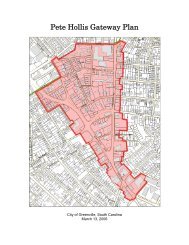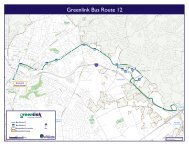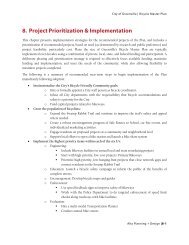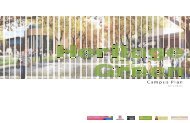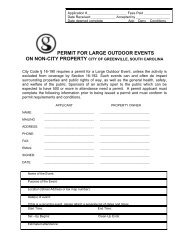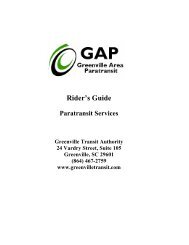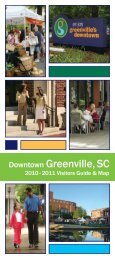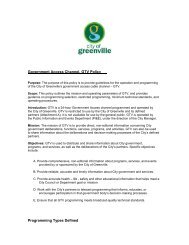Sterling Community Master Plan - Greenville County
Sterling Community Master Plan - Greenville County
Sterling Community Master Plan - Greenville County
Create successful ePaper yourself
Turn your PDF publications into a flip-book with our unique Google optimized e-Paper software.
<strong>Sterling</strong> Neighborhood <strong>Master</strong> <strong>Plan</strong> July 2010<br />
1.0 Introduction and Background<br />
1.1 <strong>Community</strong> History<br />
The history of <strong>Sterling</strong> is intricately tied to the history of <strong>Greenville</strong>. As home to several<br />
churches, the city’s first black high school, and the first local neighborhood developed<br />
exclusively for African-Americans, <strong>Sterling</strong> was a center of social, spiritual, and educational life<br />
for <strong>Greenville</strong>’s African-American community.<br />
From the beginning, the <strong>Sterling</strong> neighborhood and <strong>Sterling</strong> school had an intertwined history.<br />
In 1896 Dr. Daniel Melton Minus of the Silver Hill / John Wesley Methodist Episcopal Church<br />
of <strong>Greenville</strong> established a school for African-Americans in the City of <strong>Greenville</strong>. Known<br />
originally as <strong>Greenville</strong> Academy, the small school grew quickly in enrollment and in 1902,<br />
moved to <strong>Greenville</strong> <strong>County</strong>. The new school was named <strong>Sterling</strong> Industrial College, after Mrs.<br />
E. R. <strong>Sterling</strong> who funded the education of Reverend Minus. Of special interest is that Mr. W.<br />
R. Sewell, one of <strong>Greenville</strong>’s leading black contractors, constructed the school. The overall<br />
funding of the school was an early example of racial cooperation in <strong>Greenville</strong> involving the<br />
leadership of both the black and white business community.<br />
Mr. Thomas F. Parker of Monaghan Mills and the founder of the Parker School District was the<br />
primary financier of the school building itself. He also was the developer of the first lots and<br />
streets in the neighborhood. He named the streets in honor of school trustees – <strong>Sterling</strong>,<br />
Middleton, Minus, Malloy and Valentine. Properties were sold only to black persons and<br />
purchasers were given 5-10 years to pay for the properties.<br />
<strong>Sterling</strong> High School Photograph, Courtesy of <strong>Greenville</strong> Cultural Exchange Center<br />
In 1929, the <strong>Greenville</strong> <strong>County</strong> School District purchased the building, renamed it <strong>Sterling</strong> High<br />
School, and reopened it as the first black public high school in the <strong>County</strong>. The school<br />
curriculum included basic educational courses, as well as technical training in various trades –<br />
masonry, carpentry, tailoring, upholstery, cosmetology, auto mechanics, homemaking, and<br />
cooking. <strong>Sterling</strong> High School became an educational and social anchor for the neighborhood<br />
and for <strong>Greenville</strong>’s African-American population. Small businesses grew around the school to<br />
serve the neighborhood. They clustered along Jenkins and Calhoun Streets and included a<br />
1<br />
Continuing the community legacy and leadership



